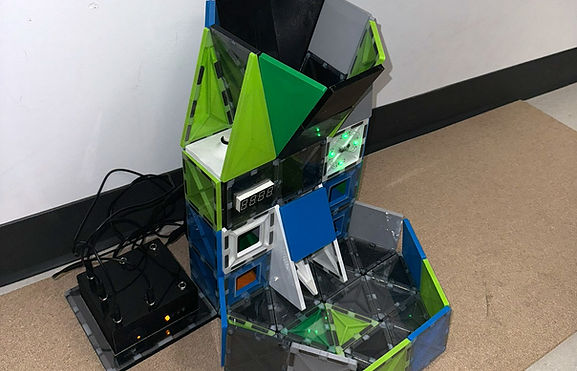Rodrigo Bassi Guerreiro
Smart Tiles
Magnetic Tiles with Embedded Electronics
This toy was developed with the goal of teaching children about core concepts in Electrical, Mechanical, and Software Engineering. It is largely inspired on the design of Magna-Tiles, which are tiles of different shapes and sizes which snap together magnetically, easily allowing for custom structures to be built.
In this product, certain tiles have electronic components embedded into them, some with "inputs" (like buttons, switches, and motion sensors), and others with outputs (like LEDs and seven-segment displays). These tiles are connected to the "brain block", which houses a microcontroller that determines their behavior based on user-inputted "code". Such "code" is written using block logic (similarly to Scratch) on a web browser, and is sent wirelessly to the brain.
Duration
Aug 2023 - Dec 2023
Team Size
9
Technologies
ESP32, 3D CAD, Soldering, Laser Cutting

Technical Details
All the tiles were 3D printed in PLA from original OnShape CAD designs, and topped off with a thin piece of laser-cut acrylic. Over 10 designs were created to make different shapes, and allow for different electronics to be inserted in an aesthetically appealing fashion.
The "brain block" has an ESP32 microcontroller in its interior, which is powered by a battery pack with an easily accessible port for recharging. The electrical connections between the microcontroller I/O pins and the components embedded in the tiles are made with TRRS connectors, which condense 4 wires (power, ground, data, and clock) into simple and intuitive plugs.
The online user interface was developed using React, while the Scratch-like coding feature was implemented in C++. The interface connects to the microcontroller in the brain via Bluetooth.
My Role
My primary role in this project was the physical integration of the electronic components into the tiles. This included modifying CAD files, exploring various models of electronics, and neatly soldering and packaging them into place.
I was also largely responsible for the fabrication of approximately 100 original tiles, from 3D printing the bases, to laser cutting the acrylic covers, to correctly orienting the magnets, to finally sealing all of the tiles shut.
Video Demo


